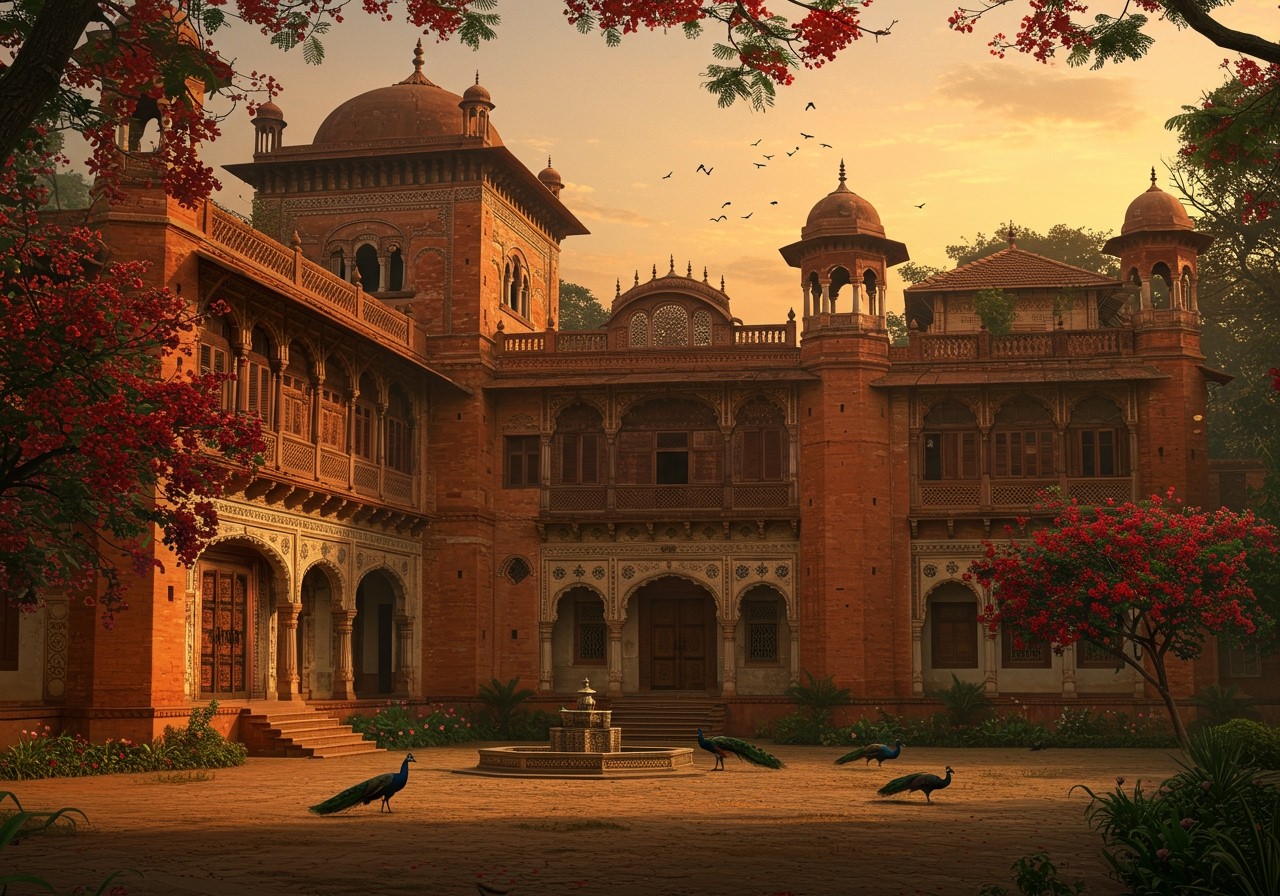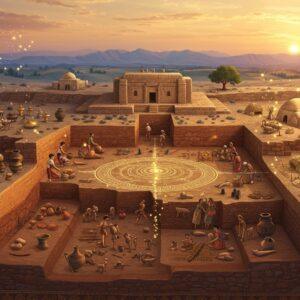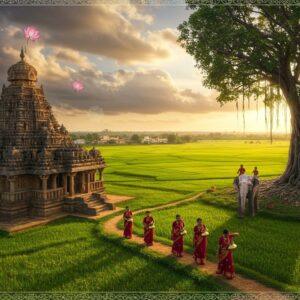
Bikrampur, steeped in history, is renowned for its traditional Bengali architecture. This unique style beautifully blends influences from various eras, creating structures that aren’t merely buildings, but integral threads in the rich tapestry of Bangladesh’s cultural identity. Preserving these architectural marvels is vital to maintaining our connection with the past. Let’s delve into what makes Bikrampur’s architecture so special.
The Bikrampur Home: A Symphony of Tradition and Design
A typical Bikrampur house, affectionately known as a ‘Bikrampur Ghor,’ showcases distinct architectural features. Often built around a central courtyard, these homes promote natural ventilation and foster social interaction. The use of locally sourced materials like bamboo, mud, and terracotta not only enhances the aesthetic appeal but also reflects a deep respect for sustainability. Intricate woodwork and carvings often adorn doorways and windows, a testament to the skill and artistry of local artisans. Decorative elements, inspired by nature and folklore, add layers of symbolic meaning to these dwellings. Verandas and open spaces play a vital role in community gatherings and daily life, while sloped roofs, a practical adaptation to the climate, effectively manage rainwater. However, the preservation of these traditional homes faces challenges due to the pressures of modernization. For homeowners keen on preserving or restoring their traditional spaces, Poojn.in offers a range of authentic bamboo and wooden products that complement the beauty of these homes.
Bikrampur Rajbari: Whispers of Grandeur and Heritage
The Rajbaris of Bikrampur, the grand palatial homes of zamindars, stand as majestic echoes of a bygone era’s opulence. These architectural masterpieces tell captivating stories of the past, their grandeur evident in expansive courtyards, soaring ceilings, and ornate facades. The design often reveals a harmonious blend of Mughal and colonial influences, from graceful arches to intricate plasterwork. The interiors of Rajbaris typically display a lavish aesthetic, with elegant chandeliers, beautiful frescoes adorning the walls, and antique furnishings adding a touch of timeless charm, reflecting both wealth and a deep-rooted cultural heritage. Once vibrant centers of social, political, and economic activity, notable Rajbaris like the Baliati Palace hold immense historical significance. Poojn.in offers a selection of traditional handcrafted items that resonate with the spirit of these grand homes. Preserving these magnificent structures, however, is a continuous challenge. While some Rajbaris stand in a state of disrepair, restoration efforts are underway for others, aiming to safeguard their legacy. There’s also growing interest in repurposing these spaces as cultural centers or museums, striking a balance between preservation and modern needs.
Cultural Significance and Preservation: A Shared Responsibility
Bikrampur’s architecture is a tangible reflection of its vibrant cultural history. Traditional houses and Rajbaris serve as vital links to the past, fostering a sense of community and continuity, connecting people to their roots. Local communities, government bodies, and heritage organizations are working hand-in-hand on restoration projects. Cultural tourism offers a promising avenue for generating awareness and raising funds. Promoting Bikrampur’s architectural heritage can attract visitors from around the globe, drawing those with a keen interest in history and culture. While urbanization and economic pressures pose significant threats to these structures, embracing sustainable practices can help strike a balance between modern development and heritage conservation. Supporting preservation efforts is crucial, and we can all contribute through advocacy and participation in cultural events. Engaging with Bikrampur’s architecture cultivates a deeper appreciation for its cultural significance.
Contemporary Relevance and Adaptation: Bridging the Past and the Future
Bikrampur’s traditional architecture continues to inspire contemporary design practices. Architects draw inspiration from these historical forms to create sustainable and culturally resonant structures. Adaptive reuse projects, blending traditional elements with modern functionality, demonstrate how Bikrampur’s architectural principles can inform eco-friendly building practices. Technology plays a vital role in preserving the architectural essence while meeting current needs. Cultural education is equally important, ensuring the transmission of this rich knowledge to future generations. Encouraging a dialogue between tradition and modernity fosters a deeper appreciation for Bikrampur’s heritage. The enduring legacy of Bikrampur’s architecture offers valuable lessons in sustainability and cultural identity. Embracing this heritage can inspire future generations to value tradition alongside innovation.
Poojn.in: Supporting Traditional Rituals in the Bikrampur Region
Poojn.in is proud to serve the Bikrampur region, including Boardangi, East Belbari, and surrounding areas of South Dinajpur, by providing authentic puja items that honor the rich architectural heritage of traditional homes and Rajbaris, delivering right to your doorstep. For homes and Rajbaris maintaining traditional worship spaces, we offer:
- Pure brass and copper utensils for daily puja: These beautiful and durable pieces enhance the sanctity of your rituals.
- Traditional clay and metal oil lamps (diyas): Illuminate your puja space with the warm glow of tradition. Explore our exquisite collection of diyas.
- Authentic wooden puja items: Crafted with reverence, these items connect you to the essence of tradition.
- Handcrafted incense holders and dhunuchi: Elevate the sensory experience of your puja with fragrant incense. Find beautifully crafted dhunuchi and other puja essentials here.
- Sacred threads and religious textiles: Enhance the spiritual significance of your rituals.
Our collection caters to both daily rituals and special ceremonies in traditional Bengali households. All items meet stringent quality standards and are carefully packaged for safe delivery. To order or inquire about specific items for your traditional home:
- Call: 03369029784
- WhatsApp: 9476142738
- Visit: www.poojn.in
We ensure prompt delivery to all addresses in Boardangi, East Belbari, Belbari, and Gangarampur areas of South Dinajpur. Our team understands the specific requirements of traditional Bengali homes and can guide you in selecting the most suitable items for your puja needs.
Embracing Bikrampur’s Architectural Legacy: A Testament to Time
Bikrampur’s architectural heritage stands as a proud testament to its rich history and cultural identity. The majestic Rajbaris and traditional homes, with their grand designs and intricate details, offer us a glimpse into a past filled with elegance and cultural richness. These structures are not mere remnants of history; they are living symbols of Bikrampur’s enduring spirit. Preserving this legacy is a shared responsibility. By supporting restoration efforts and promoting cultural tourism, we ensure that these architectural treasures continue to inspire and educate future generations. Embracing modern techniques and sustainable practices in restoration offers a path to balance the old with the new, ensuring that Bikrampur’s architectural beauty remains a source of pride and inspiration for generations to come. As we look to the future, let us celebrate the timeless elegance of Bikrampur’s architecture and honor the stories they tell. By valuing our heritage, we enrich our understanding of who we are and where we come from, fostering a deeper connection to our roots while embracing the possibilities of tomorrow.
Understanding Bikrampur’s Architecture: FAQs
What defines the architectural style of Bikrampur?
Bikrampur’s architecture is celebrated for its intricate designs, masterful traditional craftsmanship, and the unique fusion of Hindu and Mughal influences evident in its houses and Rajbaris.
How can I distinguish a typical Bikrampur house?
Look for ornate carvings, spacious courtyards, and traditional motifs. The use of local materials and the evident skilled craftsmanship highlight its cultural essence.
What sets Bikrampur Rajbaris apart?
Bikrampur Rajbaris exude grandeur with their detailed architectural elements, often featuring expansive gardens, high ceilings, and elegant interiors that reflect a regal lifestyle.
What is the cultural importance of Bikrampur Ghor?
Bikrampur Ghor represents the lifestyle and traditions of the region. They are important cultural symbols, playing a key role in preserving Bikrampur’s architectural heritage.
Is it possible to visit a Bikrampur Rajbari?
Yes, many Bikrampur Rajbaris welcome visitors, offering a fascinating glimpse into the region’s rich history and architectural beauty.
Are there any initiatives to preserve Bikrampur’s architecture?
Yes, local communities and organizations are actively working to preserve and restore Bikrampur’s traditional architecture, recognizing its historical significance.
What building materials are traditionally used in Bikrampur houses?
Traditional Bikrampur houses utilize locally sourced materials like wood, brick, and lime. These materials create durable and aesthetically pleasing structures well-suited to the local climate.
How does Bikrampur’s architecture reflect its cultural traditions?
Bikrampur’s architecture reflects cultural traditions through design elements that incorporate religious and historical motifs. These structures often serve as venues for cultural and social gatherings, playing a vital role in maintaining the region’s rich cultural heritage.
A Deeper Dive into Bengali Architectural Styles
Bengali traditional architecture is characterized by the use of readily available materials like brick and wood, echoing the styles of vernacular houses built with bamboo and thatch. Here’s a closer look:
- Materials: Brick and wood take center stage due to the scarcity of good quality stone. Terracotta plaques add a distinctive decorative touch, showcasing intricate artistry.
- Influences: A blend of ancient urban, religious, rural vernacular, colonial, and modern urban styles contribute to the rich tapestry of Bengali architecture. The “bungalow” style, originating in Bengal, became a notable architectural export.
- Styles and Features:
- Bengal Roofs: The unique sloping or curved roofs facilitate efficient drainage of heavy monsoon rainfall, a practical adaptation to the region’s climate.
- Terracotta Temples: Intricate brick carvings, particularly those found in Bishnupur, showcase the remarkable skill of Bengali artisans.
- Chala: Characterized by gabled roofs, the “ath chala” refers to a distinctive eight-sided pyramid structured roof. Temples often feature multiple towers, creating striking silhouettes against the sky.
- Bungalows: Originating in Bengal, these small, single-story houses with wide verandas offer a comfortable and airy living space.
- Regional Adaptations: Architectural styles vary across the region, reflecting local conditions and traditions:
- Northern Bengal (Hills): Houses in this region utilize materials like tin, roof tiles, lime, wood, and slate. Sloping roofs and stilt foundations are common adaptations to the hilly terrain.
- Central Bengal (Tropical): Mud, clay, bamboo, thatch, and straw are the primary building materials in this area. “Aat chala” houses, with their eight sloping roofs, are a common sight.
- South and Southwest Bengal (Heavy Monsoons): Traditional houses in these regions are built with earth, bamboo, and thatch, featuring plastered clay walls on a bamboo framework and durable grass roofs designed to withstand heavy monsoons.
- House Types: Traditional Bengali houses often fall into distinct categories:
- Chousala: These four-roomed houses are built around a central courtyard, promoting ventilation and social interaction.
- Britighar: In this style, rooms are enclosed within a single boundary, creating a private and secure living space.
- Atchala: As the name suggests, these houses feature eight roofs, a distinctive architectural element.
- Colonial Architecture: Kolkata boasts a rich collection of colonial architecture, blending Neoclassical, Gothic, and Roman styles. The Victoria Memorial, a magnificent example, showcases a harmonious blend of British and Mughal architectural influences.
Explore more about Hindu temple architecture and discover the key elements of traditional Hindu architecture for a richer understanding of these beautiful styles.


